ABS TOYOTA PRIUS C 2016 NHP10 / 1.G Owners Manual
[x] Cancel search | Manufacturer: TOYOTA, Model Year: 2016, Model line: PRIUS C, Model: TOYOTA PRIUS C 2016 NHP10 / 1.GPages: 588, PDF Size: 12.75 MB
Page 29 of 588
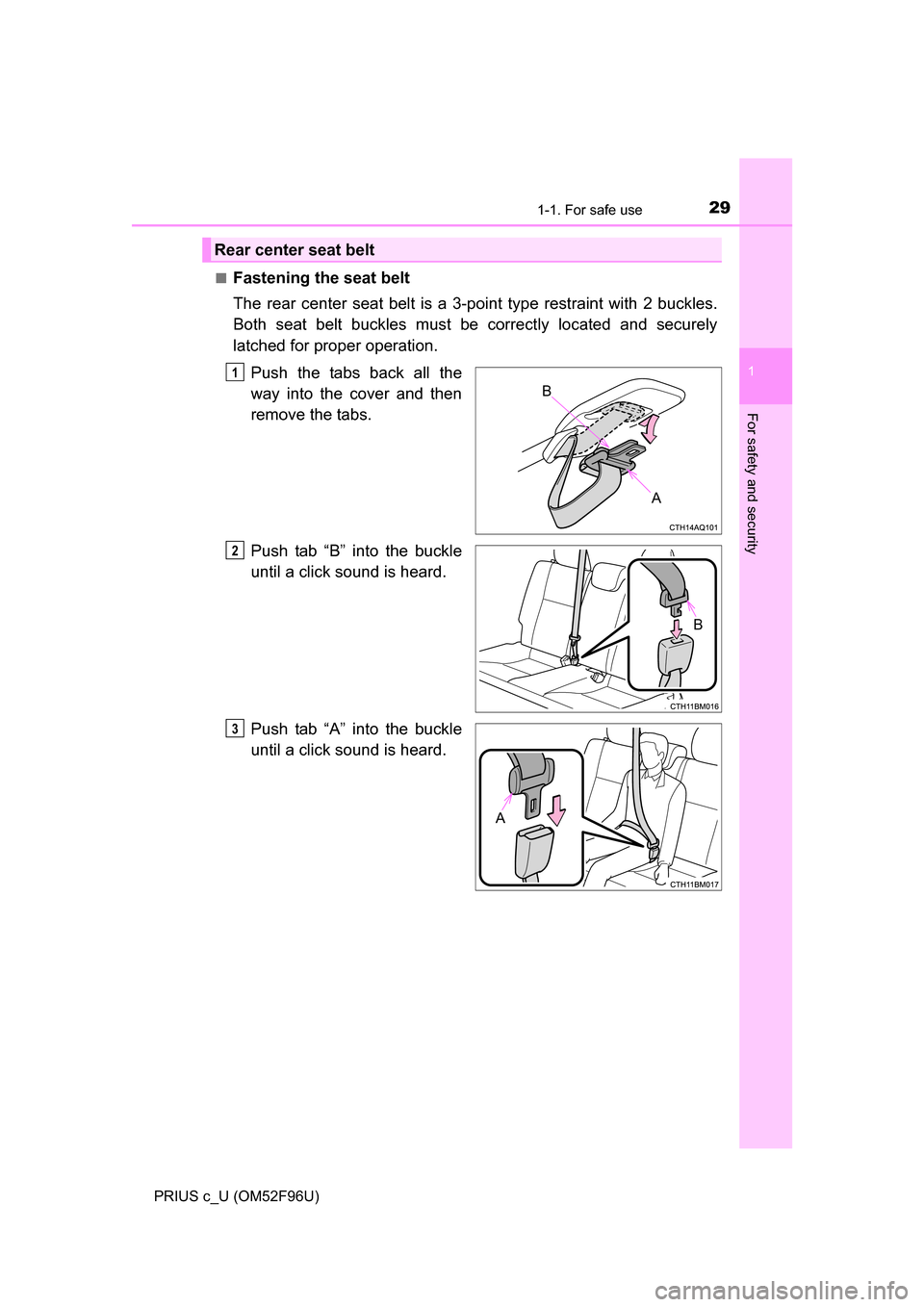
291-1. For safe use
1
For safety and security
PRIUS c_U (OM52F96U)■
Fastening the seat belt
The rear center seat belt is a 3-point type restraint with 2 buckles.
Both seat belt buckles must be correctly located and securely
latched for proper operation.
Push the tabs back all the
way into the cover and then
remove the tabs.
Push tab “B” into the buckle
until a click sound is heard.
Push tab “A” into the buckle
until a click sound is heard.
Rear center seat belt
B
A
1
B
2
A
3
Page 31 of 588
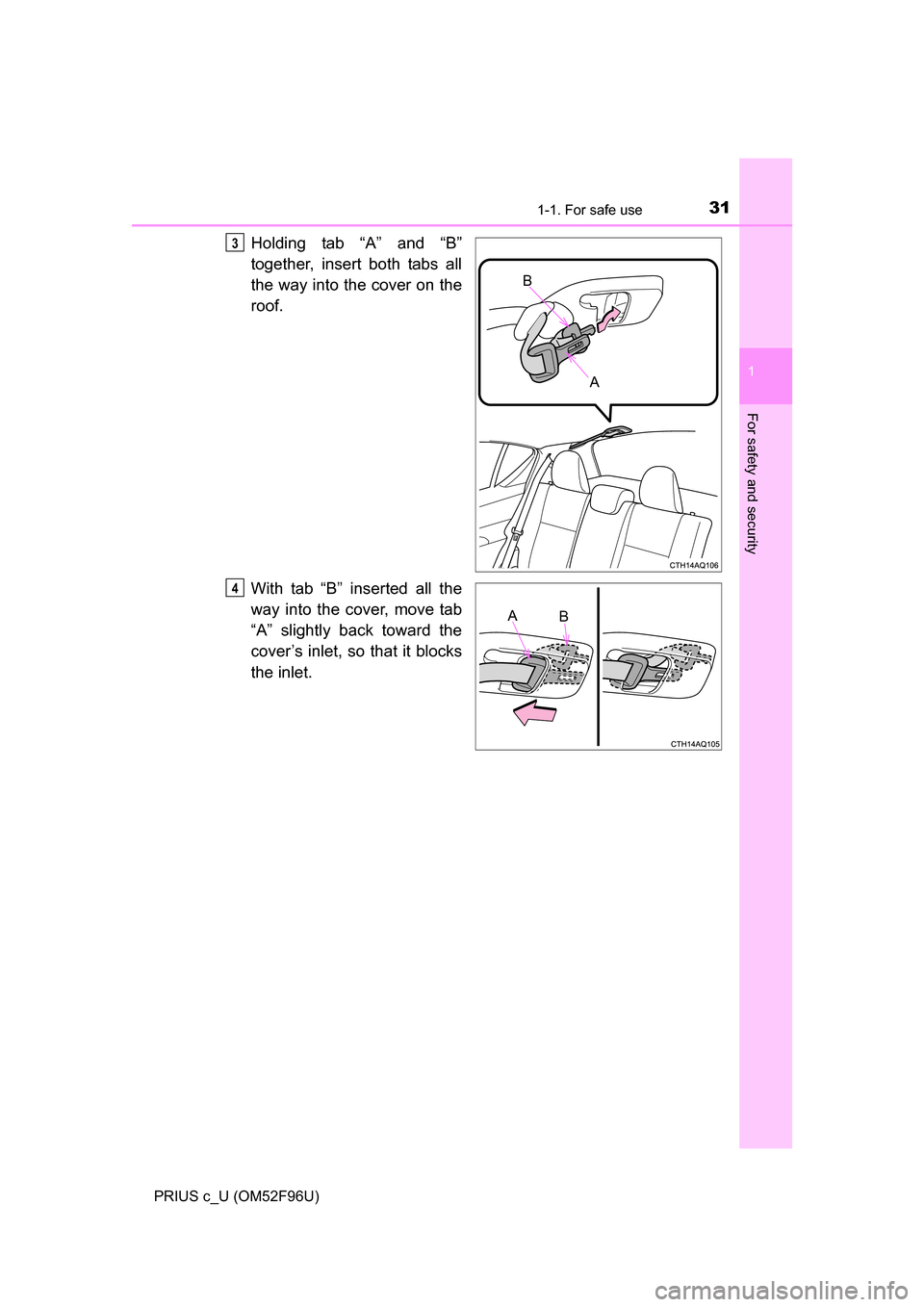
311-1. For safe use
1
For safety and security
PRIUS c_U (OM52F96U)
Holding tab “A” and “B”
together, insert both tabs all
the way into the cover on the
roof.
With tab “B” inserted all the
way into the cover, move tab
“A” slightly back toward the
cover’s inlet, so that it blocks
the inlet.
B
A
3
BA
4
Page 35 of 588
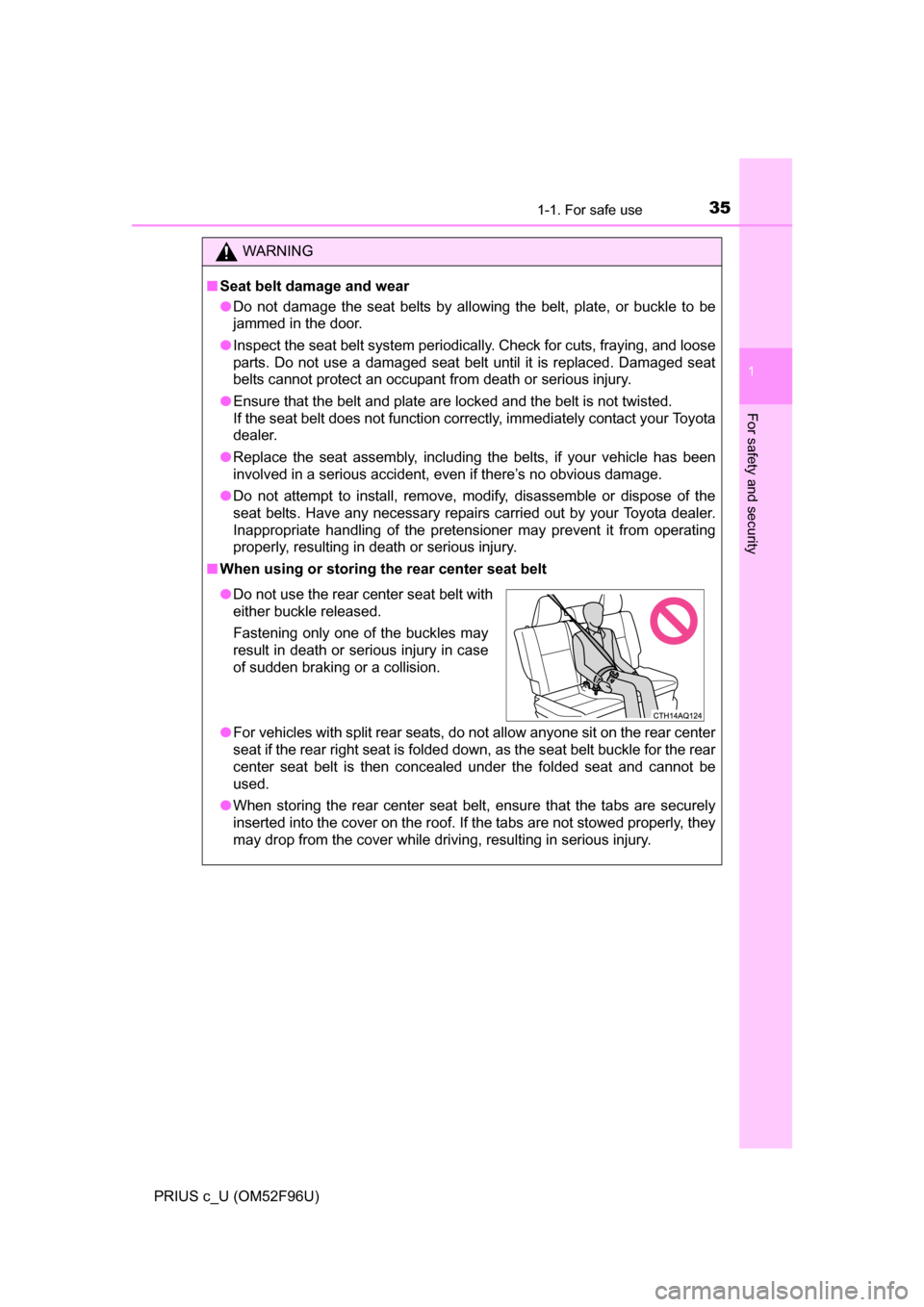
351-1. For safe use
1
For safety and security
PRIUS c_U (OM52F96U)
WARNING
■Seat belt damage and wear
●Do not damage the seat belts by allowing the belt, plate, or buckle to be
jammed in the door.
● Inspect the seat belt system periodically. Check for cuts, fraying, and loose
parts. Do not use a damaged seat belt until it is replaced. Damaged seat
belts cannot protect an occupant from death or serious injury.
● Ensure that the belt and plate are locked and the belt is not twisted.
If the seat belt does not function correctly, immediately contact your Toyota
dealer.
● Replace the seat assembly, including the belts, if your vehicle has been
involved in a serious accident, even if there’s no obvious damage.
● Do not attempt to install, remove, modify, disassemble or dispose of the
seat belts. Have any necessary repairs carried out by your Toyota dealer.
Inappropriate handling of the pretensioner may prevent it from operating
properly, resulting in death or serious injury.
■ When using or storing the rear center seat belt
● For vehicles with split rear seats, do not allow anyone sit on the rear center
seat if the rear right seat is folded down, as the seat belt buckle for the rear
center seat belt is then concealed under the folded seat and cannot be
used.
● When storing the rear center seat belt, ensure that the tabs are securely
inserted into the cover on the roof. If the tabs are not stowed properly, they
may drop from the cover while driving, resulting in serious injury.
●Do not use the rear center seat belt with
either buckle released.
Fastening only one of the buckles may
result in death or serious injury in case
of sudden braking or a collision.
Page 82 of 588

82
PRIUS c_U (OM52F96U)
1-3. Theft deterrent system
Vehicles without a smart key system
The indicator light flashes after
the key has been removed from
the engine switch to indicate that
the system is operating.
The indicator light stops flashing
after the registered key has been
inserted into the engine switch to
indicate that the system has been
canceled.
Vehicles with a smart key system
The indicator light flashes after t he “POWER” switch has been turned
off to indicate that the system is operating.
The indicator light stops flashing after the “POWER” switch has been
turned to ACCESSORY or ON mode to indicate that the system has
been canceled.
■ System maintenance
The vehicle has a maintenance-free type immobilizer system.
■ Conditions affecting operation
Depending on the surrounding environment and conditions, the immobilizer
system may not operate properly. This may prevent the hybrid system from
starting. ( P. 140)
Immobilizer system
The vehicle’s keys have built-in transponder chips that prevent
the hybrid system from starting if a key has not been previously
registered in the vehi cle’s on-board computer.
Never leave the keys inside the vehicle when you leave the vehi-
cle.
This system is designed to help prevent vehicle theft but does
not guarantee absolute security against all vehicle thefts.
: If equipped
Page 87 of 588

872. Instrument cluster
2
Instrument cluster
PRIUS c_U (OM52F96U)
Warning lights inform the driver of malfunctions in any of the vehicle's
systems.
Warning lights
*1
(U.S.A.)
Brake system warning
light ( P. 473)*1Electric power steering
system warning light
(P. 474)
*1
(Canada)
Brake system warning
light ( P. 473)*1
Slip indicator ( P. 475)
*1
(Yellow)
Brake system warning
light (P. 473)Low fuel level warning
light (P. 475)
*1Charging system warn-
ing light ( P. 474)Seat belt reminder light
(P. 475)
*1
(U.S.A.)
Malfunction indicator
lamp ( P. 474)*1
Master warning light
(P. 475)
*1
(Canada)
Malfunction indicator
lamp ( P. 474)*1
Tire pressure warning
light (P. 476)
*1
SRS warning light
(P. 474)
*1, 2
(if equipped)
PCS warning light
( P. 476)
*1
(U.S.A.)
ABS warning light
(P. 474)
(Canada)
Parking brake warning
light ( P. 200)
*1
(Canada)
ABS warning light
(P. 474)
(U.S.A)
Parking brake warning
light ( P. 200)
Page 90 of 588
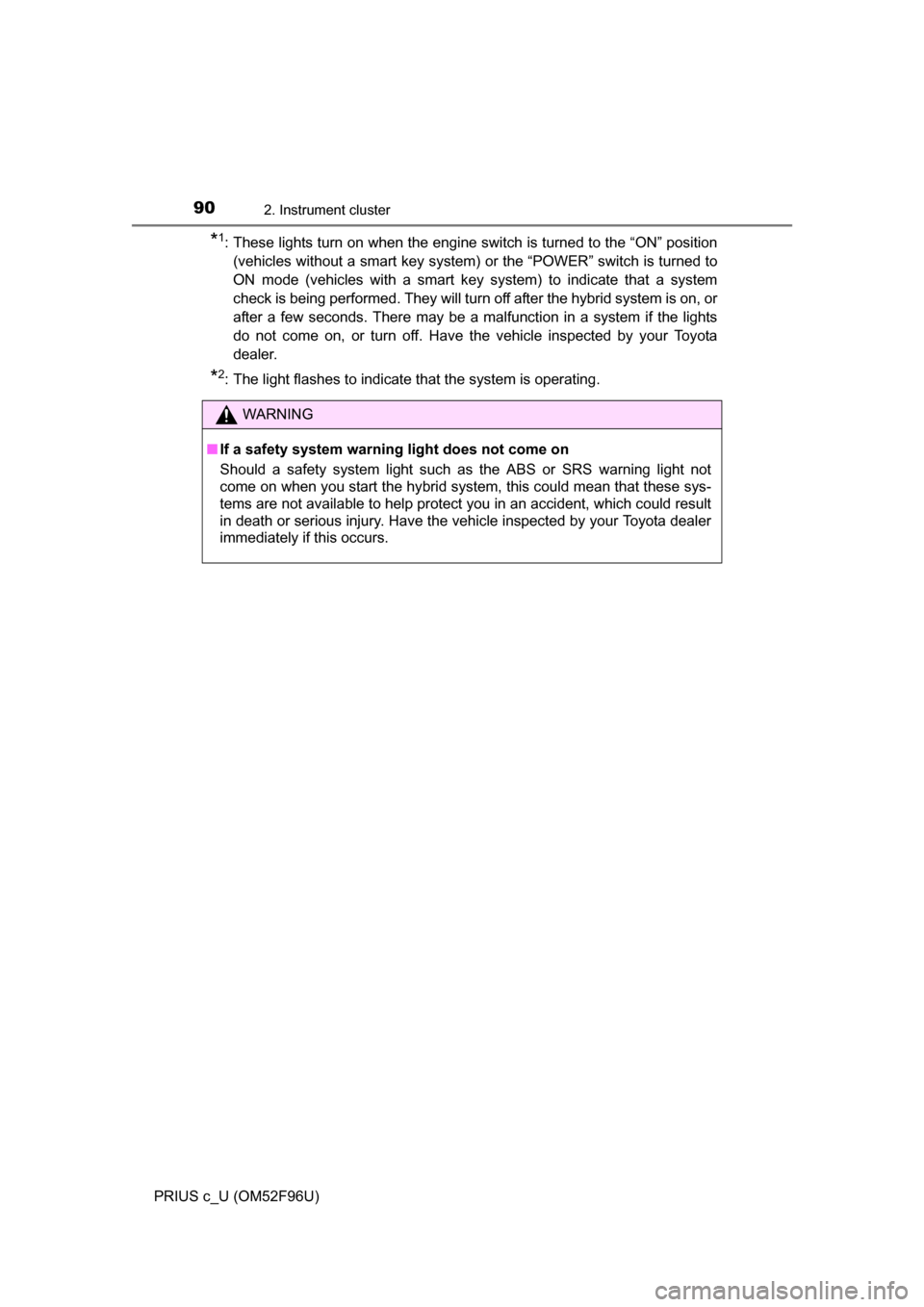
902. Instrument cluster
PRIUS c_U (OM52F96U)
*1: These lights turn on when the engine switch is turned to the “ON” position(vehicles without a smart key system) or the “POWER” switch is turned to
ON mode (vehicles with a smart key system) to indicate that a system
check is being performed. They will turn off after the hybrid system is on, or
after a few seconds. There may be a malfunction in a system if the lights
do not come on, or turn off. Have the vehicle inspected by your Toyota
dealer.
*2: The light flashes to indicate that the system is operating.
WARNING
■ If a safety system warning light does not come on
Should a safety system light such as the ABS or SRS warning light not
come on when you start the hybrid system, this could mean that these sys-
tems are not available to help protect you in an accident, which could r\
esult
in death or serious injury. Have the vehicle inspected by your Toyota dealer
immediately if this occurs.
Page 261 of 588
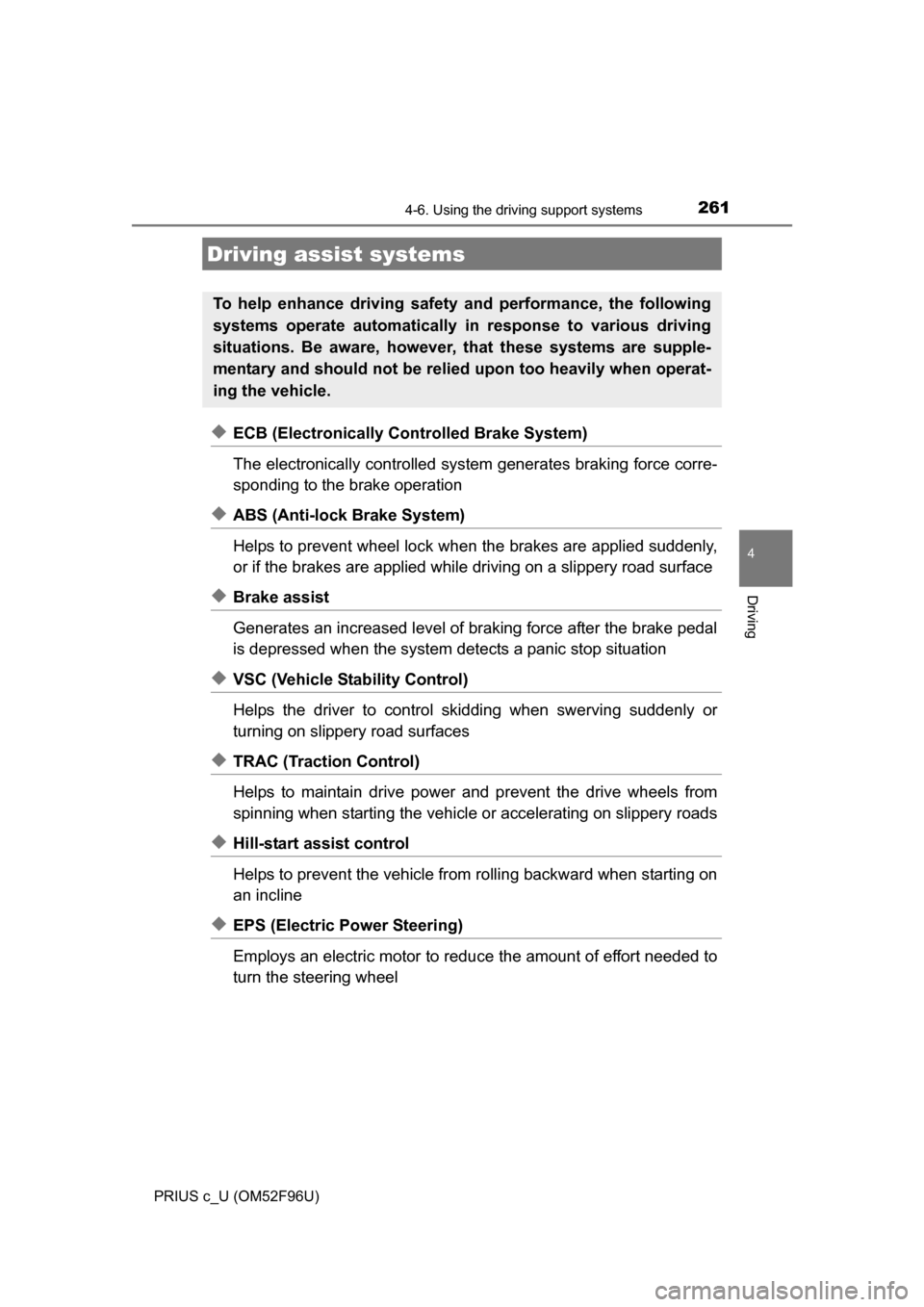
2614-6. Using the driving support systems
4
Driving
PRIUS c_U (OM52F96U)
◆ECB (Electronically Controlled Brake System)
The electronically controlled system generates braking force corre-
sponding to the brake operation
◆ABS (Anti-lock Brake System)
Helps to prevent wheel lock when the brakes are applied suddenly,
or if the brakes are applied while driving on a slippery road surface
◆Brake assist
Generates an increased level of braking force after the brake pedal
is depressed when the system detects a panic stop situation
◆VSC (Vehicle Stability Control)
Helps the driver to control skidding when swerving suddenly or
turning on slippery road surfaces
◆TRAC (Traction Control)
Helps to maintain drive power and prevent the drive wheels from
spinning when starting the vehicle or accelerating on slippery roads
◆Hill-start assist control
Helps to prevent the vehicle from rolling backward when starting on
an incline
◆EPS (Electric Power Steering)
Employs an electric motor to reduce the amount of effort needed to
turn the steering wheel
Driving assist systems
To help enhance driving safety and performance, the following
systems operate automatically in response to various driving
situations. Be aware, however, that these systems are supple-
mentary and should not be relied upon too heavily when operat-
ing the vehicle.
Page 262 of 588
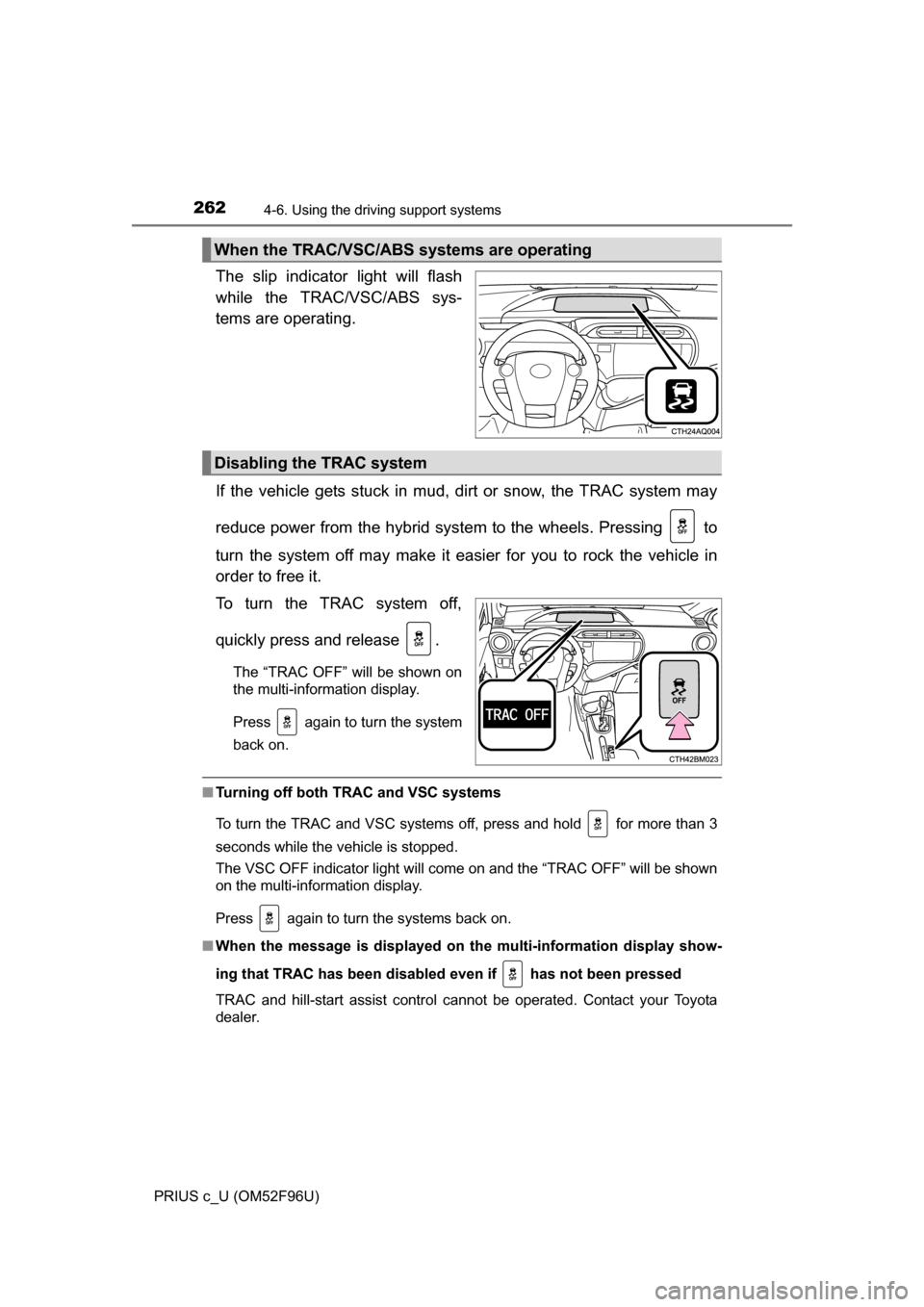
2624-6. Using the driving support systems
PRIUS c_U (OM52F96U)
The slip indicator light will flash
while the TRAC/VSC/ABS sys-
tems are operating.
If the vehicle gets stuck in mud, dirt or snow, the TRAC system may
reduce power from the hybrid syst em to the wheels. Pressing to
turn the system off may make it eas ier for you to rock the vehicle in
order to free it.
To turn the TRAC system off,
quickly press and release .
The “TRAC OFF” will be shown on
the multi-information display.
Press again to turn the system
back on.
■ Turning off both TRAC and VSC systems
To turn the TRAC and VSC systems off, press and hold for more than 3
seconds while the vehicle is stopped.
The VSC OFF indicator light will come on and the “TRAC OFF” will be shown
on the multi-information display.
Press again to turn the systems back on.
■ When the message is displayed on th e multi-information display show-
ing that TRAC has been disable d even if has not been pressed
TRAC and hill-start assist control cannot be operated. Contact your Toyota
dealer.
When the TRAC/VSC/ABS systems are operating
Disabling the TRAC system
Page 263 of 588

2634-6. Using the driving support systems
4
Driving
PRIUS c_U (OM52F96U)■
Sounds and vibrations caused by th e ABS, brake assist, TRAC, VSC and
hill-start assist control systems
Any of the following conditions may occur when the above systems are oper-
ating. None of these indicates that a malfunction has occurred.
● Vibrations may be felt through the vehicle body and steering.
● A motor sound may be heard after the vehicle comes to a stop.
● The brake pedal may pulsate slightly after the ABS is activated.
● The brake pedal may move down slightly after the ABS is activated.
■ ECB operating sound
ECB operating sound may be heard in the following cases, but it does not
indicate that a malfunction has occurred.
●Operating sound heard from engine compartment when the brake pedal is
operated.
● Motor sound of the brake system heard from the front part of the vehicle
when the driver’s door is opened.
● Operating sound heard from the engine compartment when one or two min-
utes passed after the stop of the hybrid system.
■ EPS operation sound
When the steering wheel is operated, a motor sound (whirring sound) may be
heard. This does not indicate a malfunction.
■ Reduced effectiveness of the EPS system
The effectiveness of the EPS system is reduced to prevent the system from
overheating when there is frequent steering input over an extended period of
time. The steering wheel may feel heavy as a result. Should this occur, refrain
from excessive steering input or stop the vehicle and turn the hybrid system
off. The EPS system should return to normal within 10 minutes.
■ Automatic reactivation of TRAC and VSC systems
After turning the TRAC and VSC systems off, the systems will be automati-
cally re-enabled in the following situations:
● When the engine switch is turned to the “LOCK” position (vehicles without a
smart key system) or the “POWER” switch is turned off (vehicles with a
smart key system)
● If only the TRAC system is turned off, the TRAC will turn on when vehicle
speed increases
If both the TRAC and VSC systems are turned off, automatic re-enabling will
not occur when vehicle speed increases
Page 265 of 588

2654-6. Using the driving support systems
4
Driving
PRIUS c_U (OM52F96U)
WARNING
■The ABS does not operate effectively when
●The limits of tire gripping performance have been exceeded (such as
excessively worn tires on a snow covered road).
● The vehicle hydroplanes while driving at high speed on wet or slick roads.
■ Stopping distance when the ABS is operating may exceed that of nor-
mal conditions
The ABS is not designed to shorten the vehicle’s stopping distance. Always
maintain a safe distance from the vehicle in front of you, especially in the
following situations:
● When driving on dirt, gravel or snow-covered roads
● When driving with tire chains
● When driving over bumps in the road
● When driving over roads with potholes or uneven surfaces
■ TRAC may not operat e effectively when
Directional control and power may not be achievable while driving on slip-
pery road surfaces, even if the TRAC system is operating.
Drive the vehicle carefully in conditions where stability and power may be
lost.
■ Hill-start assist control
●Do not overly rely on hill-start assist control. Hill-start assist control may
not operate effectively on steep inclines and roads covered with ice.
● Unlike the parking brake, hill-start assist control is not intended to hold the
vehicle stationary for an extended period of time. Do not attempt to use
hill-start assist control to hold the vehicle on an incline, as doing so may
lead to an accident.